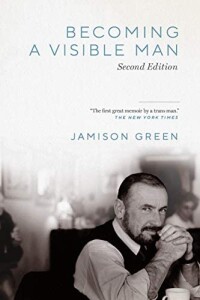 Jamison Green’s Becoming a Visible Man is an excellent autobiography of an at this point fairly well-known trans rights activist and expert. It also represents an excellent tool for individuals seeking to better understand the trans man, the issues he might run up against and the life he might lead. A popular book in its area when first printed in 2004, this second edition updates and expands itself greatly.
Jamison Green’s Becoming a Visible Man is an excellent autobiography of an at this point fairly well-known trans rights activist and expert. It also represents an excellent tool for individuals seeking to better understand the trans man, the issues he might run up against and the life he might lead. A popular book in its area when first printed in 2004, this second edition updates and expands itself greatly.
There is a very nice preface to the second edition in which the author discusses his decisions and revisions, in particular the choice to update language in many places to what is currently considered acceptable parlance and terminology. Given the fast moving and shifting nature of gender identity and gender theories, this was a wise decision and reinforces the desire for personal growth in the author.
Jamison takes readers from his early childhood up through the present day in an effort to impart a full picture of his life before and after transition. This is true not only in relation to Green’s gender and sex, but also to the myriad ways in which his life experience fed into and out of these things. Many attempts to conform, or attempts to make him conform, are discussed in detail. The failure of these attempts, or at least the pointlessness of them, gives a great deal of depth to the text. Readers are given the opportunity to see the places in which Green grew as a person, understanding himself and the world around him. Questions of gender from a lesbian, religious, general societal, and personal point of view are addressed in turn.
The text, much like most lives, veers wildly between gripping and terrifying, between heartbreak and joyous. Unexpected loss, and the inibility to read how past might go up against the future, are passed through. Attempting to come to grips with life as not only a man, but as a father, are dealt with in no small detail. It is a mark in favor of this volume that even when eventss are not depicted chronologically their placement always makes clear sense to the reader. A custody battle will be mentioned in one chapter, dropped in favor of something else that was happening at the time, and brought up in a chapter where it might be more appropriate thematically.
Long asides, indeed at times almost whole chapters, are devoted to detailed discussions of the issues related to the trans community, or how trans issues relate to another area of interests or study or advocacy. These are interesting and well-thought-out passages, and green status and history as an advocate among the FTM community gives them added weight. This status also allows tough passuages to slip organically into the text, where such material might not seem as appropriate in the autobiography of a trans celebrity more famous for something outside of advocacy.
Indeed an entire section appears discussing transition from a female to male point of view, ranging from detailed lists of options and difficulties, all the way to an itemized listing of that Jamison Green curated. When it comes to the nuts and bolts of medical transition, both from a chemical and surgical standpoint hey, this is one of the best guides for a layman that readerd are likely to find.
This second edition is stunningly current, featuring information up through the better part of 2020 when discussing legal matters and trans visibility. This material is integrated well into the text, providing up-to-date information even when relating back to very early experiences Green had.
This is a memoir by an impressive man, one who achieved comfort with his own identity at a time it was considered a radical notion. It is excellent on an instructional level, within its own admitted limits, and is easy to recommend to not only scholars of the area, but also to those who enjoy a memoir or need guidance on related matters.
(Vanderbilt, 2020)
